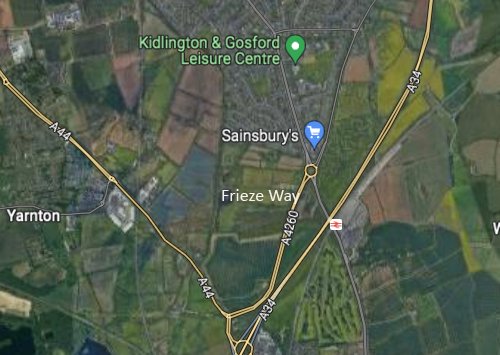What can we learn from David Brain’s death?

By Ian Loader
Ian is a member of Cyclox infrastructure group
At 18.40 on 24 February David Brain, 54, was killed by a collision with a car while cycling on Frieze Way in Kidlington. He was riding towards the A44 roundabout when he was struck by a silver VW Golf. He died at the scene as a result of his injuries. This was another preventable death on Oxfordshire’s roads, a further grim indicator of our county’s road safety crisis.
We should not blame individuals for road deaths like this, although the desire to point the finger is understandable. Instead we should treat such tragedies as moments for collective reflection and reckoning.
- They are reminders of the deadly price paid by vulnerable road users for the speed and comfort of mass motoring.
- They should lead us to reflect on road-design choices of the past, and their consequences.
- They should prompt us to reappraise infrastructures that enable speedy mobility for some, while restricting the safe movements of others.
Road deaths are, as the saying goes, teachable moments.
Frieze Way
So we need to talk about Frieze Way. As a local resident who occasionally cycles – and more often drives – down this road, this feels urgent to me.

The location of Frieze Way
The A4260 Frieze Way is a stretch of dual carriageway that runs from the A44 to the Kidlington roundabout. It is fast, and has no dedicated cycling provision. This makes it dangerous for cyclists, who rarely use it. But it is not used that much by motorists either. The very lack of motor vehicles makes it fast, and dangerous for all road users. Frieze Way runs parallel to the A34, and when the A34 was built it became legacy infrastructure. It is a road left over from another time.
North Oxford Corridor
Frieze Way sits within a rapidly changing landscape. It now forms part of the North Oxford Corridor project. One of the stated aims of this project is ‘improving pedestrian and cycle connectivity for work and leisure trips into the city’. Road safety and cycling improvements are being made. Thousands of new homes are going up and new businesses being started. Oxford North innovation district is close by. A new Oxford United football stadium is being planned for the triangle at the Kidlington end. Stratfield Brake sports ground lies opposite. The whole area will soon be a lot busier with people who want, not just to drive, but to walk, cycle or take a bus. In this changed urban environment, a stretch of fast dual carriageway starts to feel out of place. A road left over from another time.
What should be done?
So we need to do something about Frieze Way. David Brain was killed on a stretch of legacy infrastructure that is no longer fit for purpose.
The main lesson to learn from his death is that this road needs a radical re-fit. A (slower) single carriageway each way would be enough for road traffic. Bus lanes should be added (to connect Yarnton, Begbroke and Woodstock to Oxford Parkway railway station, for example). Dedicated cycle paths in both directions should also be built. If Oxfordshire County Council wants to make good on its Vision Zero commitments, and its promises to improve road safety and sustainable transport in Oxford North, action is required now. Frieze Way is the North Oxford Corridor’s blind spot.
Image credits
Google Maps
